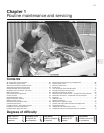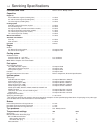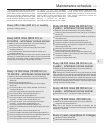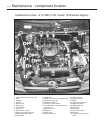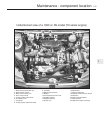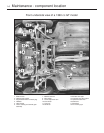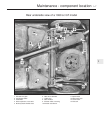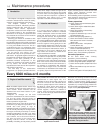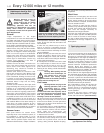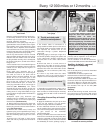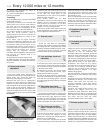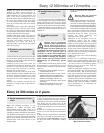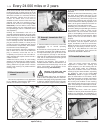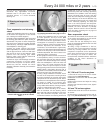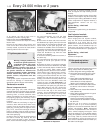
4 Allow the oil to drain into the container, and
check the condition of the plug’s sealing
washer; renew it if worn or damaged.
5 Allow some time for the old oil to drain,
noting that it may be necessary to reposition
the container as the oil flow slows to a trickle;
when the oil has completely drained, wipe
clean the drain plug and its threads in the
sump and refit the plug, tightening it securely.
6 If the filter is also to be renewed, move the
container into position under the oil filter,
which is located on the front side of the
cylinder block. On XV, XW and XY series
engines, place some rag around the filter
otherwise the oil that runs out as the filter is
unscrewed will make a mess all over the front
of the engine.
7 Using an oil filter removal tool if necessary,
slacken the filter initially, then unscrew it by
hand the rest of the way (see illustration).
Empty the oil in the old filter into the
container.
8 Use a clean rag to remove all oil, dirt and
sludge from the filter sealing area on the
engine. Check the old filter to make sure that
the rubber sealing ring hasn’t stuck to the
engine. If it has, carefully remove it.
9 Apply a light coating of clean engine oil to
the sealing ring on the new filter, then screw it
into position on the engine. Tighten the filter
firmly by hand only - do not use any tools.
10 Remove the old oil and all tools from
under the car, then lower the car to the
ground (if applicable).
11 Remove the dipstick, then unscrew the oil
filler cap from the rocker/cylinder head cover
or oil filler/breather neck (as applicable). Fill
the engine, using the correct grade and type
of oil (see “Lubricants and fluids, and
capacities”). An oil can spout or funnel may
help to reduce spillage. Pour in half the
specified quantity of oil first, then wait a few
minutes for the oil to fall to the sump.
Continue adding oil a small quantity at a time
until the level is up to the lower mark on the
dipstick. Adding approximately 1.5 litres will
bring the level up to the upper mark on the
dipstick. Refit the filler cap.
12 Start the engine and run it for a few
minutes; check for leaks around the oil filter
seal and the sump drain plug. Note that there
may be a delay of a few seconds before the oil
pressure warning light goes out when the
engine is first started, as the oil circulates
through the engine oil galleries and the new oil
filter (if fitted) before the pressure builds up.
13 Switch off the engine, and wait a few
minutes for the oil to settle in the sump once
more. With the new oil circulated and the filter
completely full, recheck the level on the
dipstick, and add more oil as necessary.
14 Dispose of the used engine oil safely, with
reference to “General repair procedures” in
the preliminary Sections of this manual.
4 Front brake pad check
1
1 Jack up the front of the vehicle, and
support it on axle stands (see “Jacking and
vehicle support”).
2 For better access to the brake calipers,
remove the roadwheels.
3 If any of the pads friction material is worn to
the specified thickness or less, all four pads
must be renewed as a set.
4 For a comprehensive check, the brake pads
should be removed and cleaned. The
operation of the caliper can then also be
checked, and the condition of the brake disc
itself can be fully examined on both sides.
Refer to Chapter 9 for further information.
5 Automatic transmission fluid
level check
1
1 Take the vehicle on a short journey, to
warm the transmission up to normal operating
temperature, then park the vehicle on level
ground. The fluid level is checked using the
dipstick located at the front of the engine
compartment, directly in front of the engine
(see illustration). The dipstick top is brightly-
coloured for easy identification.
2 With the engine idling and the selector lever
in the “P” (Park) position, withdraw the
dipstick from the tube, and wipe all the fluid
from its end with a clean rag or paper towel.
Insert the clean dipstick back into the tube as
far as it will go, then withdraw it once more.
Note the fluid level on the end of the dipstick;
it should be between the upper and lower
marks (see illustration).
3 If topping-up is necessary, add the required
quantity of the specified fluid to the transmission
via the dipstick tube. Use a funnel with a fine-
mesh gauze, to avoid spillage, and to ensure
that no foreign matter enters the transmission.
Note: Never overfill the transmission so that the
fluid level is above the upper mark.
4 After topping-up, take the vehicle on a short
run to distribute the fresh fluid, then recheck
the level again, topping-up if necessary.
5 Always maintain the level between the two
dipstick marks. If the level is allowed to fall
below the lower mark, fluid starvation may
result, which could lead to severe
transmission damage.
6 Frequent need for topping-up indicates that
there is a leak, which should be found and
corrected before it becomes serious.
Every 6000 miles or 6 months 1•9
1
5.2 Automatic fluid dipstick lower (a) and
upper (b) fluid level markings
For a quick check, the
thickness of the friction
material on each brake pad
can be measured through
the aperture in the caliper body
3.7 Using an oil filter removal tool to slacken the filter 5.1 Withdrawing the automatic transmission fluid dipstick



